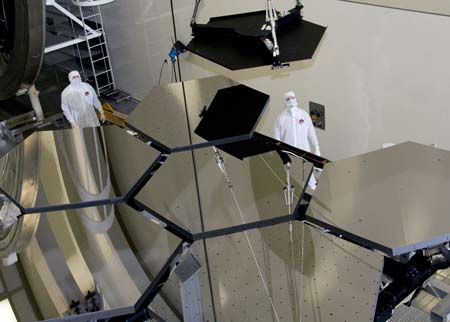Browsing the Webb
The James Webb Space Telescope just cleared its most significant milestone, the Mission Critical Design Review. This means that the orbiting infrared observatory, scheduled to launch on an Ariane 5 rocket no earlier than June 2014 into orbit around the sun, about a million miles from Earth, is expe…
The James Webb Space Telescope just cleared its most significant milestone, the Mission Critical Design Review. This means that the orbiting infrared observatory, scheduled to launch on an Ariane 5 rocket no earlier than June 2014 into orbit around the sun, about a million miles from Earth, is expected to meet all science and engineering requirements for its mission.

The telescope (here's one of many cool artist's concepts) is a joint project of NASA, the European Space Agency, and the Canadian Space Agency. Development of the 18 complex mirror segments has been in progress for several years. The segments will unfold and combine to create a single mirror about 21 feet across, 2.7 times the diameter and six times the total area of the Hubble Space Telescope's mirror. At 14,300 pounds overall, the Webb telescope is a bit more than half the weight of the Hubble, despite a sunshade that will unfold in space to the size of a tennis court. The shade will protect the telescope's sensitive instruments from the radiation given off by the sun, Earth and moon.
The mirrors are now being polished at Ball Aerospace in Boulder, Colorado. The backplane of the telescope, the structure that supports the mirror segments, is being manufactured by Alliant Techsystems (ATK) in Magna, Utah. ATK is best known as the manufacturer of the solid rocket boosters for the space shuttle. The mirror segments' positions on the backplane will need to be fine-tuned to tolerances just a fraction of the width of a human hair in order to focus light on the device's sensitive instruments as the Webb peers farther into the universe, and therefore farther back in time, than any telescope in history.

The telescope (here's one of many cool artist's concepts) is a joint project of NASA, the European Space Agency, and the Canadian Space Agency. Development of the 18 complex mirror segments has been in progress for several years. The segments will unfold and combine to create a single mirror about 21 feet across, 2.7 times the diameter and six times the total area of the Hubble Space Telescope's mirror. At 14,300 pounds overall, the Webb telescope is a bit more than half the weight of the Hubble, despite a sunshade that will unfold in space to the size of a tennis court. The shade will protect the telescope's sensitive instruments from the radiation given off by the sun, Earth and moon.
The mirrors are now being polished at Ball Aerospace in Boulder, Colorado. The backplane of the telescope, the structure that supports the mirror segments, is being manufactured by Alliant Techsystems (ATK) in Magna, Utah. ATK is best known as the manufacturer of the solid rocket boosters for the space shuttle. The mirror segments' positions on the backplane will need to be fine-tuned to tolerances just a fraction of the width of a human hair in order to focus light on the device's sensitive instruments as the Webb peers farther into the universe, and therefore farther back in time, than any telescope in history.